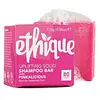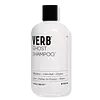What's inside
What's inside
 Key Ingredients
Key Ingredients

 Benefits
Benefits

 Concerns
Concerns

 Ingredients Side-by-side
Ingredients Side-by-side

Sodium Coco-Sulfate
CleansingSodium Cocoyl Isethionate
CleansingStearic Acid
CleansingDecyl Glucoside
CleansingWater
Skin ConditioningTheobroma Cacao Seed Butter
EmollientBrassica Alcohol
EmollientGlycerin
HumectantLactic Acid
BufferingCocos Nucifera Oil
MaskingCaprylic/Capric Triglyceride
MaskingCocos Nucifera Fruit
AbrasiveCitrus Paradisi Peel Oil
MaskingSodium Isethionate
CleansingLimonene
PerfumingBehentrimonium Methosulfate
Parfum
MaskingMica
Cosmetic ColorantCI 77891
Cosmetic ColorantCI 77491
Cosmetic ColorantSodium Coco-Sulfate, Sodium Cocoyl Isethionate, Stearic Acid, Decyl Glucoside, Water, Theobroma Cacao Seed Butter, Brassica Alcohol, Glycerin, Lactic Acid, Cocos Nucifera Oil, Caprylic/Capric Triglyceride, Cocos Nucifera Fruit, Citrus Paradisi Peel Oil, Sodium Isethionate, Limonene, Behentrimonium Methosulfate, Parfum, Mica, CI 77891, CI 77491
Water
Skin ConditioningSodium Lauroyl Methyl Isethionate
CleansingCocamidopropyl Betaine
CleansingSodium Cocoyl Isethionate
CleansingSodium Lauroyl Sarcosinate
CleansingCocamidopropyl Hydroxysultaine
CleansingSaccharum Officinarum Extract
MoisturisingSimmondsia Chinensis Seed Oil
EmollientMoringa Oleifera Seed Oil
EmollientAloe Barbadensis Leaf Juice
Skin ConditioningCocodimonium Hydroxypropyl Hydrolyzed Rice Protein
Skin ConditioningChamomilla Recutita Flower Extract
MaskingCamellia Sinensis Leaf Extract
AntimicrobialHydrolyzed Vegetable Protein Pg-Propyl Silanetriol
Skin ConditioningCitrus Aurantium Dulcis Fruit Extract
MaskingCitrus Limon Fruit Extract
MaskingPyrus Malus Fruit Extract
Skin ConditioningLavandula Angustifolia Flower Extract
CleansingRosa Centifolia Flower Extract
AstringentHelianthus Annuus Seed Extract
Skin ConditioningHydrolyzed Soy Protein
HumectantHydrolyzed Quinoa
Skin ConditioningGlycol Distearate
EmollientPanthenol
Skin ConditioningParfum
MaskingCitric Acid
BufferingPPG-2 Hydroxyethyl Coco/Isostearamide
Coconut Acid
CleansingGuar Hydroxypropyltrimonium Chloride
Skin ConditioningGlycerin
HumectantCocamidopropylamine Oxide
CleansingCoco-Glucoside
CleansingGlyceryl Oleate
EmollientTrisodium Ethylenediamine Disuccinate
Tetrasodium Glutamate Diacetate
Silicone Quaternium-8
Sodium Isethionate
CleansingPolyquaternium-7
Sodium Laurate
CleansingPolyquaternium-44
Tetrasodium EDTA
Magnesium Nitrate
Cocamidopropyl Dimethylamine
EmulsifyingLactic Acid
BufferingSodium Sarcosinate
Sodium Hydroxide
BufferingSodium Glycolate
BufferingMagnesium Chloride
Ethylhexylglycerin
Skin ConditioningHydrogen Peroxide
AntimicrobialSodium Formate
BufferingTocopherol
AntioxidantHydrogenated Palm Glycerides Citrate
EmollientDisodium EDTA
Lecithin
EmollientAscorbyl Palmitate
AntioxidantPhenoxyethanol
PreservativeSodium Benzoate
MaskingMethylchloroisothiazolinone
PreservativeMethylisothiazolinone
PreservativePotassium Sorbate
PreservativeBenzyl Alcohol
PerfumingChlorphenesin
AntimicrobialSorbic Acid
PreservativeHydroxycitronellal
PerfumingButylphenyl Methylpropional
PerfumingLimonene
PerfumingWater, Sodium Lauroyl Methyl Isethionate, Cocamidopropyl Betaine, Sodium Cocoyl Isethionate, Sodium Lauroyl Sarcosinate, Cocamidopropyl Hydroxysultaine, Saccharum Officinarum Extract, Simmondsia Chinensis Seed Oil, Moringa Oleifera Seed Oil, Aloe Barbadensis Leaf Juice, Cocodimonium Hydroxypropyl Hydrolyzed Rice Protein, Chamomilla Recutita Flower Extract, Camellia Sinensis Leaf Extract, Hydrolyzed Vegetable Protein Pg-Propyl Silanetriol, Citrus Aurantium Dulcis Fruit Extract, Citrus Limon Fruit Extract, Pyrus Malus Fruit Extract, Lavandula Angustifolia Flower Extract, Rosa Centifolia Flower Extract, Helianthus Annuus Seed Extract, Hydrolyzed Soy Protein, Hydrolyzed Quinoa, Glycol Distearate, Panthenol, Parfum, Citric Acid, PPG-2 Hydroxyethyl Coco/Isostearamide, Coconut Acid, Guar Hydroxypropyltrimonium Chloride, Glycerin, Cocamidopropylamine Oxide, Coco-Glucoside, Glyceryl Oleate, Trisodium Ethylenediamine Disuccinate, Tetrasodium Glutamate Diacetate, Silicone Quaternium-8, Sodium Isethionate, Polyquaternium-7, Sodium Laurate, Polyquaternium-44, Tetrasodium EDTA, Magnesium Nitrate, Cocamidopropyl Dimethylamine, Lactic Acid, Sodium Sarcosinate, Sodium Hydroxide, Sodium Glycolate, Magnesium Chloride, Ethylhexylglycerin, Hydrogen Peroxide, Sodium Formate, Tocopherol, Hydrogenated Palm Glycerides Citrate, Disodium EDTA, Lecithin, Ascorbyl Palmitate, Phenoxyethanol, Sodium Benzoate, Methylchloroisothiazolinone, Methylisothiazolinone, Potassium Sorbate, Benzyl Alcohol, Chlorphenesin, Sorbic Acid, Hydroxycitronellal, Butylphenyl Methylpropional, Limonene
 Reviews
Reviews

Ingredients Explained
These ingredients are found in both products.
Ingredients higher up in an ingredient list are typically present in a larger amount.
Glycerin is already naturally found in your skin. It helps moisturize and protect your skin.
A study from 2016 found glycerin to be more effective as a humectant than AHAs and hyaluronic acid.
As a humectant, it helps the skin stay hydrated by pulling moisture to your skin. The low molecular weight of glycerin allows it to pull moisture into the deeper layers of your skin.
Hydrated skin improves your skin barrier; Your skin barrier helps protect against irritants and bacteria.
Glycerin has also been found to have antimicrobial and antiviral properties. Due to these properties, glycerin is often used in wound and burn treatments.
In cosmetics, glycerin is usually derived from plants such as soybean or palm. However, it can also be sourced from animals, such as tallow or animal fat.
This ingredient is organic, colorless, odorless, and non-toxic.
Glycerin is the name for this ingredient in American English. British English uses Glycerol/Glycerine.
Learn more about GlycerinLactic Acid is another well-loved alpha hydroxy acid (AHA). It is gentler than glycolic acid but still highly effective.
Its main role is to exfoliate the surface of the skin by loosening the “glue” that holds dead skin cells together. Shedding those old cells leads to smoother, softer, and more even-toned skin.
Because lactic acid molecules are larger than glycolic acid, they don’t penetrate as deeply. This means they’re less likely to sting or irritate, making it a great choice for beginners or those with sensitive skin.
Like glycolic acid, it can:
Lactic acid also acts as a humectant (like hyaluronic acid). It can draw water into the skin to improve hydration and also plays a role in the skin's natural moisturizing factor (NMF) in the form of sodium lactate.
Studies show it can boost ceramide production to strengthen the skin barrier and even help balance the skin’s microbiome.
To get results, choose products with a pH between 3-4.
Lower strengths (5-12%) focus on surface exfoliation; higher strengths (12% and up) can reach deeper in the dermis (deeper, supportive layer) to improve skin texture and firmness over time.
Though it was originally derived from milk, most modern lactic acid used in skincare is vegan. It is made through non-dairy fermentation to create a bio-identical and stable form suitable for all formulations.
When lactic acid shows up near the end of an ingredient list, it usually means the brand added just a tiny amount to adjust the product’s pH.
Legend has it that Cleopatra used to bathe in sour milk to help reduce wrinkles.
Lactic acid is truly a gentle multitasker: it exfoliates, hydrates, strengthens, and brightens. It's a great ingredient for giving your skin a smooth, glowing, and healthy look without the harshness of stronger acids.
Read more about some other popular AHA's here:
Learn more about Lactic AcidLimonene is a fragrance that adds scent and taste to a formulation.
It's found in the peel oil of citrus fruits and other plants such as lavender and eucalyptus. The scent of limonene is generally described as "sweet citrus".
Limonene acts as an antioxidant, meaning it helps neutralize free radicals.
When exposed to air, oxidized limonene may sensitize the skin. Because of this, limonene is often avoided by people with sensitive skin.
The term 'fragrance' is not regulated in many countries. In many cases, it is up to the brand to define this term. For instance, many brands choose to label themselves as "fragrance-free" because they are not using synthetic fragrances. However, their products may still contain ingredients such as essential oils that are considered a fragrance.
Learn more about LimoneneParfum is a catch-all term for an ingredient or more that is used to give a scent to products.
Also called "fragrance", this ingredient can be a blend of hundreds of chemicals or plant oils. This means every product with "fragrance" or "parfum" in the ingredients list is a different mixture.
For instance, Habanolide is a proprietary trade name for a specific aroma chemical. When used as a fragrance ingredient in cosmetics, most aroma chemicals fall under the broad labeling category of “FRAGRANCE” or “PARFUM” according to EU and US regulations.
The term 'parfum' or 'fragrance' is not regulated in many countries. In many cases, it is up to the brand to define this term.
For instance, many brands choose to label themselves as "fragrance-free" because they are not using synthetic fragrances. However, their products may still contain ingredients such as essential oils that are considered a fragrance by INCI standards.
One example is Calendula flower extract. Calendula is an essential oil that still imparts a scent or 'fragrance'.
Depending on the blend, the ingredients in the mixture can cause allergies and sensitivities on the skin. Some ingredients that are known EU allergens include linalool and citronellol.
Parfum can also be used to mask or cover an unpleasant scent.
The bottom line is: not all fragrances/parfum/ingredients are created equally. If you are worried about fragrances, we recommend taking a closer look at an ingredient. And of course, we always recommend speaking with a professional.
Learn more about ParfumSodium cocoyl isethionate is a natural ingredient from coconut oil. It is an ultra gentle cleanser that gives a nice foam without drying the skin or impacting the skin barrier.
The amount of foam created depends on the amount of sodium cocoyl isethionate used in the product.
This ingredient also helps improve the spreadability of a product.
Learn more about Sodium Cocoyl IsethionateWe don't have a description for Sodium Isethionate yet.
Water. It's the most common cosmetic ingredient of all. You'll usually see it at the top of ingredient lists, meaning that it makes up the largest part of the product.
So why is it so popular? Water most often acts as a solvent - this means that it helps dissolve other ingredients into the formulation.
You'll also recognize water as that liquid we all need to stay alive. If you see this, drink a glass of water. Stay hydrated!
Learn more about Water